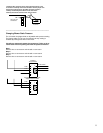
2
Safety Precautions
• Before installation and electric work
Before installing the unit, make sure you read all the “Safety
precautions”.
The “Safety precautions” provide very important points regarding
safety. Make sure you follow them.
• Symbols used in the text
Warning:
Describes precautions that should be observed to prevent
danger of injury or death to the user
Caution:
Describes precautions that should be observed to prevent
damage to the unit
Warning:
Carefully read the labels affixed to the main unit.
Warning:
• The unit must be installed by an authorized Dealer or
properly trained technician.
− Improper installation by the user may result in water
leakage, electric shock, or fire.
• Install the air unit in a place that can withstand its
weight.
− Inadequate strength may cause the unit to fall down,
resulting in injuries.
• Use the specified cables for wiring. Make the
connections securely so that the outside force of the
cable is not applied to the terminals.
− Inadequate connection and fastening may generate heat
and cause a fire.
• Prepare for typhoons, hurricanes, earthquakes etc. and
install the unit at the specified place.
− Improper installation may cause the unit to topple and result
in injury.
• Never repair the unit. If the air conditioner must be
repaired, consult the dealer.
− If the unit is repaired improperly, water leakage, electric
shock, or fire may result.
• Do no touch the heat exchanger fins.
− Improper handling may result in injury.
• When handling the product, always wear protective
equipment.
− EG: Gloves, full arm protection, and safety glasses.
− Improper handling may result in injury.
• Install the air conditioner according to this Installation
Manual.
− If the unit is installed improperly, water leakage, electric
shock, or fire may result.
• Have all electric work done by a licensed electrician
according the “National Electrical code and local
Electrical codes” and “Interior Wire Regulations” and
the instructions given in this manual and always use a
special circuit.
− If the power source capacity is inadequate or electric work
is performed improperly, electric shock and fire may result.
• Keep the electric parts away from water (washing water
etc.).
−
It might result in electric shock, catching fire or smoke.
• When cleaning the Heat Exchanger and Drain Pan,
ensure the Control Box, Motor and LEV remain dry,
using a water proof covering.
• When installing and moving the air conditioner to
another site, do not charge it with a refrigerant different
from the refrigerant specified on the unit.
− If a different refrigerant or air is mixed with the original
refrigerant, the refrigerant cycle may malfunction and the
unit may be damaged.
• When moving and reinstalling the air conditioner,
consult the dealer or an authorized technician.
− If the air conditioner is installed improperly, water
leakage, electric shock, or fire may result.
• Do not reconstruct or change the settings of the
protections devices.
− If the pressure switch, thermal switch, or other protection
devices are shorted and operated forcibly, or parts other
than those specified by Mitsubishi Electric are used, fire
or explosion may result.
• To dispose of this product, consult your dealer.
• Do not use a leak detection additive.
Precautions for devices that use R410A refrigerant.
Caution:
• Do not use the existing refrigerant piping.
− The old refrigerant and refrigeration oil in the existing
piping contains a large amount of chlorine which may
cause the refrigerator oil of the new unit to deteriorate.
• Use refrigerant piping made of C1220 (Cu-DHP)
phosphorus deoxidized copper as specified in the JIS
H3300 “Copper and copper alloy seamless pipes and
tubes”. In addition, be sure that the inner and outer
surfaces of the pipes are clean and free of hazardous
sulphur, oxides, dust/dirt, shaving particles, oils,
moisture, or any other contaminants.
− Contaminants on the inside of the refrigerant piping may
cause the refrigerant residual oil to deteriorate
• Store the piping to be used during installation indoors
and keep both ends of the piping sealed until just
before brazing. (Store elbows and other joints in a
plastic bag.)
− If dust, dirt, or water enters the refrigerant cycle,
deterioration of the oil and compressor trouble may result.
• Use liquid refrigerant to fill the system.
− If gas refrigerant is used to seal the system, the
composition of the refrigerant in the cylinder will change
and performance may drop.
• Do not use a refrigerant other than R410A.
− If another refrigerant is used, the chlorine in the
refrigerant may cause the refrigerator oil to deteriorate.
• Use a vacuum pump with a reverse flow check valve.
− The vacuum pump oil may flow back into the refrigerant
cycle and cause the refrigerator oil to deteriorate.
• Do not use the following tools that are used with
conventional refrigerants.
− (Gauge manifold, charge hose, gas leak detector,
reverse flow check valve, refrigerant charge base,
vacuum gauge, refrigerant recovery equipment).
− If the conventional refrigerant and refrigeration oil are
mixed in the R410A, the refrigerant may deteriorate.
− If water is mixed in the R410A, the refrigeration oil may
deteriorate.
− Since R410A does not contain any chlorine, gas leak
detectors for conventional refrigerant will not react to it.
• Be especially careful when managing the tools.
− If dust, dirt, or water gets in the refrigeration system, the
refrigerant may deteriorate.










